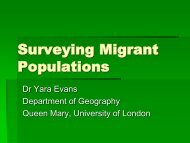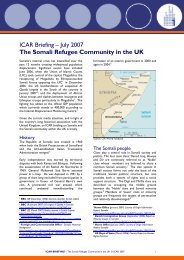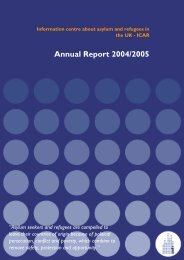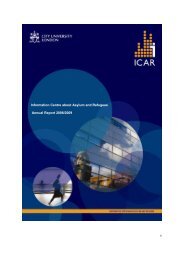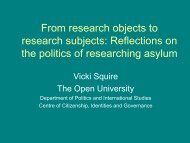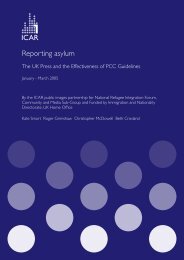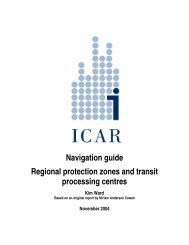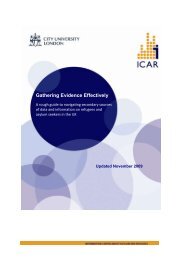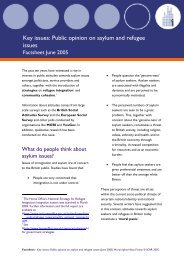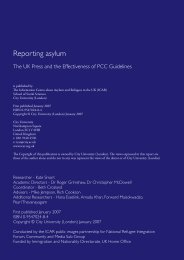Uncovered: assessing media and communications needs ... - ICAR
Uncovered: assessing media and communications needs ... - ICAR
Uncovered: assessing media and communications needs ... - ICAR
- No tags were found...
You also want an ePaper? Increase the reach of your titles
YUMPU automatically turns print PDFs into web optimized ePapers that Google loves.
1.2.3 DefinitionsFor the purposes of this research the ‘refugee’ category has included people seeking asylum <strong>and</strong>those who have been granted refugee status or leave to remain in the UK. Migrant workers aredefi ned as people who have come to the UK to seek work. While some refugee support organisationsinclude migrant workers in their work, others restrict their concern to those coming to the UK underthe terms of the 1951 United Nations Refugee Convention. Locally, migrant support groups arepredominantly focused on those arriving in the UK to work.For the ‘Faith’ sector the researchers sought to contact representatives <strong>and</strong> individuals from a rangeof religions, including Christian denominations, Islam, Hinduism, Sikhism, Baha’ism <strong>and</strong> Judaism.‘Isolated Rural’ organisations were identifi ed in consultation with two national bodies, the Commissionfor Rural Communities (CRC) <strong>and</strong> Action with Communities in Rural Engl<strong>and</strong> (ACRE). For the specifi cinvestigation it was decided to focus on organisations in remote parts of Herefordshire.Black <strong>and</strong> minority ethnic groups were contacted with the help of national <strong>and</strong> local infrastructure <strong>and</strong>support organisations.Respondents to the questionnaire were invited to select their group categorisation from the fouroptions outlined above <strong>and</strong>/or a fi fth option, ‘other’.1.2.4 LimitationsThe researchers are confi dent that, within the limits of the project, the fi ndings are representative ofthe <strong>media</strong> <strong>and</strong> <strong>communications</strong> training <strong>needs</strong> across the sectors chosen for this research. However,the following considerations should be taken into account:• Each sector includes an extensive <strong>and</strong> varied range of organisations with different aims <strong>and</strong>priorities. The timescale of this research has enabled us to gain an indicative insight into theirgeneral <strong>needs</strong> <strong>and</strong> capacity.• Infrastructure organisations within each sector have been immensely supportive <strong>and</strong> co-operativewith this research but ultimately it has been up to individual groups <strong>and</strong> representatives to decide towhat extent they have been able to respond. At the time of the research, rural organisations weredistracted fi rst by the impact of the fl oods <strong>and</strong> later by outbreaks of ‘Blue Tongue’ disease. Similarly,the former Commission for Racial Equality was in the process of being reconstituted within the newEquality <strong>and</strong> Human Rights Commission (EHRC).• The questionnaire used in the research was available to be completed either electronically orin downloadable form. Respondents were self-selecting after being alerted by national <strong>and</strong>infrastructure organisations. Although some sectors such as ‘isolated rural’ <strong>and</strong> ‘BME’ are identifi edas such by external monitors they do not always label themselves as such <strong>and</strong> may for exampleplace higher priority on their identity with other groups or activities, such as transport or politicalcauses. Additionally, respondents particularly in the ‘isolated rural’ sector are likely to includeorganisations whose remit includes less isolated communities.• Many of the organisations involved in the research are run on a part time basis by volunteers withlittle time to spare for surveys.• Email <strong>communications</strong> do not produce high response rates, necessitating additional timeconsumingquestioning by telephone.• While people in some sectors, for example refugees <strong>and</strong> migrant workers, might form groupings<strong>and</strong> meet regularly in the normal course of events, others such as faith, isolated rural <strong>and</strong> BME maynot be involved in formal networks. As such they are more diffi cult to identify <strong>and</strong> contact.<strong>Uncovered</strong>: <strong>assessing</strong> <strong>media</strong> <strong>and</strong> <strong>communications</strong> <strong>needs</strong> <strong>and</strong> capacity of marginalised communities13





